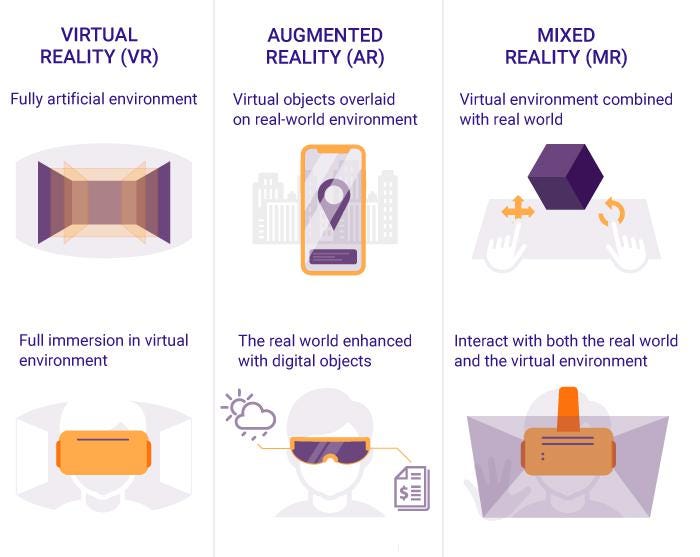Hello again! My second blog entry will be about the the differences between four concepts: Extended Reality (XR), Augmented Reality (AR), Virtual Reality (VR) and Mixed Reality (MR).
XR, AR, VR, MR,… What??
Extended Reality (XR): XR is a “catch-all”-term for technologies that enhance or replace our view of the real world. This can be done through overlaying or immersing computer text and graphics into real-world and virtual environments, or even a combination of both. XR encompasses AR, VR and MR.
Augmented Reality (AR): AR enhances our view of the real world by overlaying the real-world environment with digital content across multiple sensory modalities. It detects objects in the real-world environment and overlaps those with computer-generated data such as graphics, sounds, images, and texts. In other words: AR comines the real world with the digital world. Users can experience AR very easily through an smartphone application, but also through special AR wearables (i.e. headsets, glasses), displays, projectors or even contact lenses.
Virtual Reality (VR): While AR enhances the user’s real environment, VR completely replaces it with a virtual one. By using full-coverage headsets the user’s real-world surroundings are completely shut out while using. Advanced VR experiences even allow users to move in a digital environment and hear sounds. Moreover, special hand controllers can be used to enhance VR experiences.
Mixed Reality (MR): MR is the newest of these immersive technologies and combines aspects of AR and VR. When experiencing MR, virtual content is not only overlaid on the real environment (as in AR) but is anchored to and interacts with that environment. Instead of relying only on remote control devices, smart glasses, or smartphones, users can also use their gestures, glancing or blinking, and much more to interact with the real and the digital world at the same time.
Long Story short:
- Extended Reality (XR) is an umbrella term for technologies that enhance or replace our view of the real world
- Augmented Reality (AR) overlays virtual objects on the real-world environment
- Virtual Reality (VR) immerses users in a fully artificial digital environment
- Mixed Reality (MR) not just overlays but anchors virtual objects to the real world
For a better understanding, I found this nice infographic:

Okay, got it. But why AR?
As far as I know at this point, all three techniques – AR, MR & VR – can be useful for educational purposes. The choice of the technology might depend on several factors like the field of education, the equipment or the target group. Still, I chose to focus on AR for several reasons: 1) I like the idea of learning new things by enhancing the user’s environmental view instead of replacing it like it is with VR (my subjective opinion); 2) AR is easily accessible via smartphones or tablets, while VR and MR need more advanced technology (i.e. headsets). There might come up more advantages (and maybe some limitations and disadvantages too) the further I dive into the topic, let’s see. But that’s it for now! 🙂
_____
Sources:
Headerimage: https://www.vsight.io/the-difference-between-ar-vr-and-mr/
Infographic: https://rubygarage.org/blog/difference-between-ar-vr-mr
Arm Blueprint. (2021, 11. August). xR, AR, VR, MR: What’s the Difference in Reality? Verfügbar unter: https://www.arm.com/blogs/blueprint/xr-ar-vr-mr-difference
RubyGarage. (2021, 27. August). VR vs AR vs MR: Differences and Real-Life Applications. https://rubygarage.org/blog/difference-between-ar-vr-mr
Vsight. (2021, 9. Oktober). The difference between AR, VR, and MR. Verfügbar unter: https://www.vsight.io/the-difference-between-ar-vr-and-mr/
